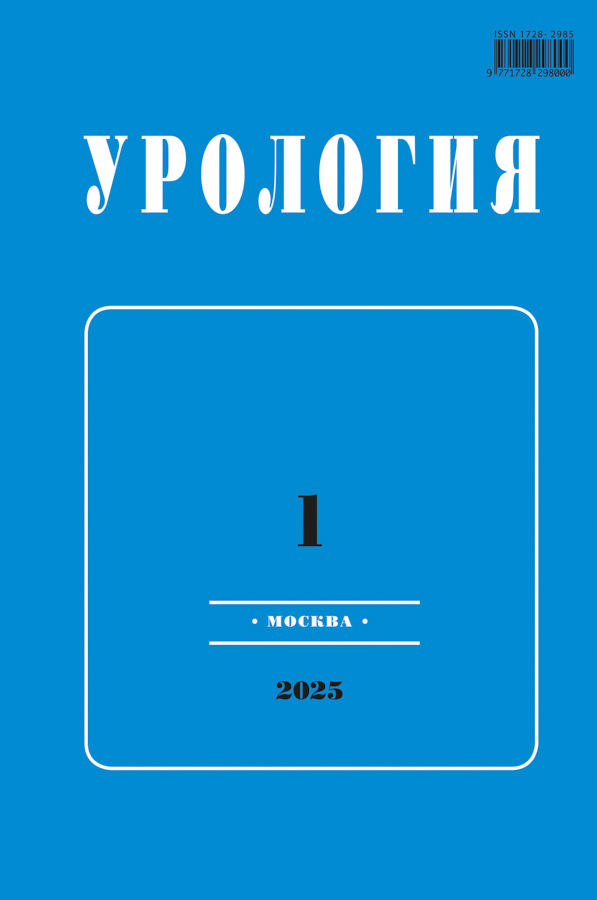A complication of ureteral stenting due to incorrect tactics, leading to nephroureterectomy
- Autores: Bychkova N.V.1, Bazaev V.V.1, Podoinitsin A.A.1, Setdikova G.R.1
-
Afiliações:
- GBUZ Moscow district “Moscow Regional Research Clinical Institute named after M.F. Vladimirsky
- Edição: Nº 1 (2025)
- Páginas: 79-83
- Seção: Clinical case
- ##submission.datePublished##: 02.07.2025
- URL: https://journals.eco-vector.com/1728-2985/article/view/687314
- DOI: https://doi.org/10.18565/urology.2025.1.79-83
- ID: 687314
Citar
Texto integral
Resumo
Minimally invasive drainage of the upper urinary tract by putting ureteral stents is an accepted and widespread procedure in case of obstructive pyelonephritis and renal colic, including symptomatic upper urinary tract dilation in pregnant women. In addition, ureteral stenting has a wide range of indications in reconstructive interventions, in which it is necessary to “strengthen” the ureter for various periods of time, and is also used as a palliative measure to ensure the outflow of urine in incurable patients. At the same time, in order to avoid stent-associated complications, it is necessary to regular carefully evaluate patients, remembering the “palliative nature” of such procedures, and to correctly choose the indications for the stent placement. Our article describes combinations of problems in treatment tactics by putting ureteral stents, which led to a life-threatening purulent destructive complication and the need for nephroureterectomy.
Palavras-chave
Texto integral
Sobre autores
Natalia Bychkova
GBUZ Moscow district “Moscow Regional Research Clinical Institute named after M.F. Vladimirsky
Autor responsável pela correspondência
Email: nat.uro@mail.ru
ORCID ID: 0000-0001-9082-5978
associate professor, Ph.D., Senior Researcher of the Department of Urology
Rússia, 61/2 Shchepkina str., Moscow 129110Vladimir Bazaev
GBUZ Moscow district “Moscow Regional Research Clinical Institute named after M.F. Vladimirsky
Email: vvbazaev@rambler.ru
ORCID ID: 0000-0001-5421-8900
Ph.D, MD, leading researcher of the Department of Urology
Rússia, 61/2 Shchepkina str., Moscow 129110Aleksey Podoinitsin
GBUZ Moscow district “Moscow Regional Research Clinical Institute named after M.F. Vladimirsky
Email: a4955145801@gmail.com
ORCID ID: 0000-0001-9739-6248
Ph.D, MD, Head of the Department of Urology
Rússia, 61/2 Shchepkina str., Moscow 129110Galiya Setdikova
GBUZ Moscow district “Moscow Regional Research Clinical Institute named after M.F. Vladimirsky
Email: galiya84@mail.ru
ORCID ID: 0000-0002-5262-4953
Código SPIN: 6551-0854
Ph.D, MD, Head of the Department of morphological diagnostics of Oncology division
Rússia, 61/2 Shchepkina str., Moscow 129110Bibliografia
- Clinical recommendations of the European Association of Urologists. Recommendations for urolithiasis.2020. p. 13–33. ISBN 978-94-92-671-07-03. Russian (Клинические рекомендации Европейской ассоциации урологов. Рекомендации по мочекаменной болезни. 2020. С. 13–33. ISBN 978-94-92-671-07-03).
- Handbook of urologist 2021. Red. M.A. Gazimiev, K.A. Shiranov. MEDCONGRESS: Moscow 2021 p.103–115. Russian (Справочник уролога 2021. Ред. М.А. Газимиев, К.А. Ширанов. ООО «МЕДКОНГРЕСС»: М., 2021 с.103-115).
- Bazaev V.V., Nikolskaya I.G., Bychkova N.V. et al. Complications of ureteral stenting in urolithiasis and obstructive pyelonephritis of pregnant women. Russian Bulletin of the obstetrician-gynecologist. 2016;16(3):52–59. http://doi.org /10.17116/rosakush201616352-59. Russian (Базаев В.В., Никольская И.Г., Бычкова Н.В., и соавт. Осложнения стентирования мочеточников при мочекаменной болезни и обструктивном пиелонефрите беременных. Российский вестник акушера-гинеколога. 2016;16(3):52–59. http://doi.org/ 10.17116/rosakush201616352-59).
- Nikolskaya I.G., Bychkova N.V., Klimova A.V. Obstructive uropathy in pregnant women: urological and obstetric complications. Nephrology and Dialysis. 2020;22(3):328–339 http://doi.org/10.28996/2618-9801-2020-3-328-339. Russian (Никольская И.Г., Бычкова Н.В., Климова А.В. Обструктивная уропатия у беременных: урологические и акушерские осложнения. Нефрология и диализ. 2020;22(3):328–339. http://doi.org/ 10.28996/2618-9801-2020-3-328-339).
- Perepanova T.S., Kozlov R.S., Rudnov V.A., Sinyakova L.A., Palagin I.S. Antimicrobial therapy and prevention of infections of the kidneys, urinary tract and male genital organs. Federal clinical guidelines. Moscow: Publishing House «UroMedia» 2022; 81–83. Russian (Перепанова Т.С., Козлов Р.С., Руднов В.А., Синякова Л.А., Палагин И.С. Антимикробная терапия и профилактика инфекций почек, мочевыводящих путей и мужских половых органов. Федеральные клинические рекомендации. М: Издательский дом «УроМедиа» 2022; 81–83).
- Wang J., Zhang X., Zhang T., Mu J., Bail B., Lei Y. The role of solifenacin as monoterapy or combination with tamsulosin in ureteral stent-related symptoms: a systematic review and meta-analisis. World J Urol. 2017;.35(11):1669-1680. doi: 10.1007/s00345-017-2051-3.
- Chew B.H., Knudsen B.E., Nott L. et al. Pilot study of ureteral movement in stented patients: First step in undestanding dynamic ureteral anatomy to improve stent discomfort. J. Endourol. 2007;21:1069–1075.
- Martov A.G., Ergakov D.V., Kornienko S.I. et al. Improving the quality of life of patients with internal stents by changing their shape. Urologiia. 2011;2:7–13. Russian (Мартов А.Г., Ергаков Д.В., Корниенко С.И. и др. Улучшение качества жизни пациентов с внутренними стентами путем изменения их формы. Урология. 2011;2:7–13).
Arquivos suplementares











